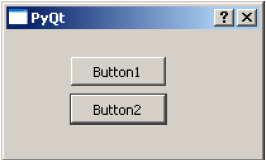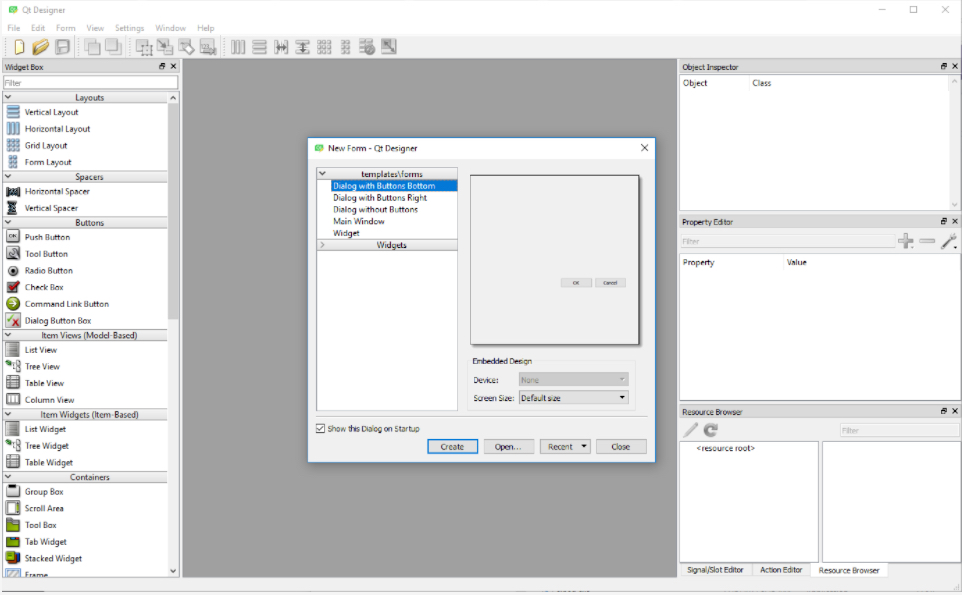1. Introduction of Signal Slot Mechanism
The connection mechanism uses a vector indexed by signals. But all the slots waste space in the vector and there are usually more slots than signals in an object. So from Qt 4.6, a new internal signal index which only includes the signal index is used. While developing with Qt, you only need to know about the absolute method index. The signal and slot operation are used to handle events and signals of the objects or widgets at the python app development level. It will also enable communication between some designed objects. The following steps are needed for creating a Python signal and slot operations. When the clicked signal of a button is emitted, QSignalMapper's map slot is invoked (thanks to the connect call in the for loop). If a mapping exists for the object that emitted the signal, the mapped(int) signal is emitted with the integer value set using setMapping. That signal is in turn connected to the Keypad's digitClicked(int) signal. So I have a need to pass around a numpy array in my PyQt Application. I first tried using the new-style signals/slots, defining my signal with: newChunkToProcess = pyqtSignal(np.array), however this gives the error: TypeError: Required argument 'object' (pos 1) not found. The Signal class provides a way to declare and connect Qt signals in a pythonic way. PySide adopt PyQt's new signal and slot syntax as-is. The PySide implementation is functionally compatible with the PyQt 4.5 one, with the exceptions listed bellow.
1. Introduction of signal slots
Signal slot is the core mechanism of Qt and also the mechanism of object communication in PyQt programming.In Qt, the QObject object and all controls in PyQt that inherit from QWidget support the slot mechanism.When the signal is transmitted, the connected slot function is automatically executed.In PyQt5, the signal and slot functions are connected by the object.signal.connect() method.
The characteristics of the signal slot are as follows:
(1) One signal can connect multiple slots
(2) One signal may connect another signal
(3) Signal parameters can be of any Python type
(4) One slot can monitor multiple signals
(5) The connection between signal and slot can be synchronous or asynchronous.
(6) Signal-slot connections can cross threads
(7) Signal can be disconnected
When writing a class, the signal and slot of the class are defined first, and the signal and slot are connected in the class to realize data transmission between objects.When an event or state changes, a signal is issued that triggers the execution of the slot function associated with the event or signal.The signal slot mechanism is illustrated as follows:
2. Define the signal
PyQt's built-in signals are automatically defined, using the PyQt5.QtCore.pyqtSignal function to create a signal for a QObject object, and using the pyqtSignal function to define the signal as a property of a class.
The types parameter denotes the type of parameters that define the signal, the name parameter denotes the name of the signal, and the class's attribute name is used by default.
Use the pyqtSignal function to create one or more overloaded unbound signals as attributes of the class, signals can only be defined in subclasses of QObject.Signals must be defined at class creation time and cannot be added dynamically as attributes of a class after it is created.When a signal is defined using the pyqtSignal function, it can pass multiple parameters and specify the type of the signal transfer parameters, which are standard Python data types, including strings, dates, Boolean types, numbers, lists, dictionaries, tuples.
3. Operational signal
The connect function binds the signal to the slot function, the disconnect function unbinds the signal to the slot function, and the emit function emits the signal.
QObject.signal.connect(self, slot, type=None, no_receiver_check=False)
Establish the connection of signal to slot function, type is connection type.
QObject.signal.disconnect(self, slot=None)
Disconnect signal from slot
emit(self, *args)
Send signal, args is variable parameter.
2. Signal and Slot Application
1. Built-in signal and slot function
The built-in signal is the signal automatically defined by the QObject object, and the built-in slot function is the slot function automatically defined by the QObject object. The built-in signal of the QObject object can be connected to the slot function of the QObject object through the QObject.signal.connect function.
2. Built-in signal and custom slot function
When a button is clicked, the button's built-in clicked signal is triggered to execute the bound custom slot function onClose.
3. Custom signal and built-in slot function
By connecting the built-in signal clicked to the custom slot function onClose, a custom signal closeSignal is sent within the custom slot function onClose, and the custom signal closeSignal is connected to the built-in slot function close.
4. Custom Signal and Custom Slot Function
3. Advances in signal slot applications
1. Custom Signal Slot
Signal objects are usually defined through class variables, and custom signals are defined before u init_u functions.
The slot function definition of a class is the same as the general method definition of a class.
Signal and slot function can belong to the same QObject object or different QObject objects by connect ing signal and slot function.
The signal is sent by the emit method.
2. Signal slot transfer custom parameters
The number of parameters emitted by the signal in Qt must be greater than or equal to the number of parameters of the slot function. PyQt uses custom parameter transfer to solve the problem that there are more parameters in the slot function than in the signal.A Lambda expression or a functools partial function can be used to pass custom parameters to the slot function, which can be of any Python type.

3. Signal slots and ornaments
Signal and slot functions can be defined in PyQt using a Python decorator as follows:
The sender object name is the object name set for the QObject object using setObjectName, and the connectSlotsByName function connected to the slot function by the signal name is as follows:
QtCore.QMetaObject.connectSlotsByName(self, QObject)
ConneSlotsByName is used to connect certain signals of QObject descendant objects to corresponding slot functions of certain QObject objects by name.
4. Event handling mechanism
1. The difference between event mechanism and signal slot mechanism
PyQt provides a high-level signal slot mechanism and a low-level event processing mechanism for event processing, which is an advanced encapsulation of event processing mechanisms.When using a control, you don't need to consider the event handling mechanism, you only need to care about the signal slot. For a custom derived control, you must consider the event handling mechanism and re-implement the corresponding event handling function according to the behavior requirements of the control.
2. Method of event handling

PyQt provides five event handling and filtering methods:
(1) Re-implement event handling functions
Common event handling functions such as paintEvent, mouseMoveEvent, mousePressEvent, mouseReleaseEvent, and so on.
(2) Re-implement the QObject.event event distribution function
When adding new events, you need to re-implement the QObject.event method and add distribution routes for new events.
(3) Install event filters
If the installEventFilter method is called on a QObject object, an event filter is installed on the QObject object.All events of the QObject object are first passed to the event filter eventFilter function, in which certain events can be discarded or modified, custom event handling mechanisms are used for events of interest, and default event handling mechanisms are used for other events.Event filtering mechanism filters all events of QObject, so more events to filter can affect program performance.
(4) Install event filters in QApplication
Installing event filters on QApplication objects filters all events on all QObject objects and gets events first, which are sent to QApplication's event filters before sending them to any other event filters.
(5) Notfy method for QApplication
PyQt distributes events using the notify method of the QApplication object. The only way to capture events before any event filter is to re-implement the notify method of the QApplication.
3. Examples of event handling
The QDialog dialog automatically exits when the ESC key is pressed, and the ESC key is pressed using event handling and filtering.
(1) Re-implement event handling functions
(2) Re-implement the event function
(3) QObject Installation Event Filter
(4) QApplication Installation Event Filter
Posted by globalinsites on Sun, 21 Jul 2019 09:24:23 -0700
This blog is part of a series of blogs explaining the internals of signals and slots.
In this article, we will explore the mechanisms powering the Qt queued connections.
Summary from Part 1
In the first part, we saw that signalsare just simple functions, whose body is generated by moc. They are just calling QMetaObject::activate, with an array of pointers to arguments on the stack.Here is the code of a signal, as generated by moc: (from part 1) Harrahs casino north kansas city missouri.
QMetaObject::activatewill then look in internal data structures to find out what are the slots connected to that signal.As seen in part 1, for each slot, the following code will be executed:
So in this blog post we will see what exactly happens in queued_activateand other parts that were skipped for the BlockingQueuedConnection
Qt Event Loop
A QueuedConnection will post an event to the event loop to eventually be handled.
When posting an event (in QCoreApplication::postEvent),the event will be pushed in a per-thread queue(QThreadData::postEventList).The event queued is protected by a mutex, so there is no race conditions when threadspush events to another thread's event queue.
Once the event has been added to the queue, and if the receiver is living in another thread,we notify the event dispatcher of that thread by calling QAbstractEventDispatcher::wakeUp.This will wake up the dispatcher if it was sleeping while waiting for more events.If the receiver is in the same thread, the event will be processed later, as the event loop iterates.
Signals And Slots Pyqt Array Java
The event will be deleted right after being processed in the thread that processes it.

An event posted using a QueuedConnection is a QMetaCallEvent. When processed, that event will call the slot the same way we call them for direct connections.All the information (slot to call, parameter values, ..) are stored inside the event.
Copying the parameters
The argv coming from the signal is an array of pointers to the arguments. The problem is that these pointers point to the stack of the signal where the arguments are. Once the signal returns, they will not be valid anymore. So we'll have to copy the parameter values of the function on the heap. In order to do that, we just ask QMetaType. We have seen in the QMetaType article that QMetaType::create has the ability to copy any type knowing it's QMetaType ID and a pointer to the type.
To know the QMetaType ID of a particular parameter, we will look in the QMetaObject, which contains the name of all the types. We will then be able to look up the particular type in the QMetaType database.
queued_activate
We can now put it all together and read through the code ofqueued_activate, which is called by QMetaObject::activate to prepare a Qt::QueuedConnection slot call.The code showed here has been slightly simplified and commented:
Upon reception of this event, QObject::event will set the sender and call QMetaCallEvent::placeMetaCall. That later function will dispatch just the same way asQMetaObject::activate would do it for direct connections, as seen in Part 1
BlockingQueuedConnection
BlockingQueuedConnection is a mix between DirectConnection and QueuedConnection. Like with aDirectConnection, the arguments can stay on the stack since the stack is on the thread thatis blocked. No need to copy the arguments.Like with a QueuedConnection, an event is posted to the other thread's event loop. The event also containsa pointer to a QSemaphore. The thread that delivers the event will release thesemaphore right after the slot has been called. Meanwhile, the thread that called the signal will acquirethe semaphore in order to wait until the event is processed.
It is the destructor of QMetaCallEvent which will release the semaphore. This is good becausethe event will be deleted right after it is delivered (i.e. the slot has been called) but also whenthe event is not delivered (e.g. because the receiving object was deleted).
A BlockingQueuedConnection can be useful to do thread communication when you want to invoke afunction in another thread and wait for the answer before it is finished. However, it must be donewith care.
The dangers of BlockingQueuedConnection
You must be careful in order to avoid deadlocks.
Obviously, if you connect two objects using BlockingQueuedConnection living on the same thread,you will deadlock immediately. You are sending an event to the sender's own thread and then are locking thethread waiting for the event to be processed. Since the thread is blocked, the event will never beprocessed and the thread will be blocked forever. Qt detects this at run time and prints a warning,but does not attempt to fix the problem for you.It has been suggested that Qt could then just do a normal DirectConnection if both objects are inthe same thread. But we choose not to because BlockingQueuedConnection is something that can only beused if you know what you are doing: You must know from which thread to what other thread theevent will be sent.
The real danger is that you must keep your design such that if in your application, you do aBlockingQueuedConnection from thread A to thread B, thread B must never wait for thread A, or you willhave a deadlock again.
When emitting the signal or calling QMetaObject::invokeMethod(), you must not have any mutex lockedthat thread B might also try locking.

Signal and slot function can belong to the same QObject object or different QObject objects by connect ing signal and slot function.
The signal is sent by the emit method.
2. Signal slot transfer custom parameters
The number of parameters emitted by the signal in Qt must be greater than or equal to the number of parameters of the slot function. PyQt uses custom parameter transfer to solve the problem that there are more parameters in the slot function than in the signal.A Lambda expression or a functools partial function can be used to pass custom parameters to the slot function, which can be of any Python type.
3. Signal slots and ornaments
Signal and slot functions can be defined in PyQt using a Python decorator as follows:
The sender object name is the object name set for the QObject object using setObjectName, and the connectSlotsByName function connected to the slot function by the signal name is as follows:
QtCore.QMetaObject.connectSlotsByName(self, QObject)
ConneSlotsByName is used to connect certain signals of QObject descendant objects to corresponding slot functions of certain QObject objects by name.
4. Event handling mechanism
1. The difference between event mechanism and signal slot mechanism
PyQt provides a high-level signal slot mechanism and a low-level event processing mechanism for event processing, which is an advanced encapsulation of event processing mechanisms.When using a control, you don't need to consider the event handling mechanism, you only need to care about the signal slot. For a custom derived control, you must consider the event handling mechanism and re-implement the corresponding event handling function according to the behavior requirements of the control.
2. Method of event handling
PyQt provides five event handling and filtering methods:
(1) Re-implement event handling functions
Common event handling functions such as paintEvent, mouseMoveEvent, mousePressEvent, mouseReleaseEvent, and so on.
(2) Re-implement the QObject.event event distribution function
When adding new events, you need to re-implement the QObject.event method and add distribution routes for new events.
(3) Install event filters
If the installEventFilter method is called on a QObject object, an event filter is installed on the QObject object.All events of the QObject object are first passed to the event filter eventFilter function, in which certain events can be discarded or modified, custom event handling mechanisms are used for events of interest, and default event handling mechanisms are used for other events.Event filtering mechanism filters all events of QObject, so more events to filter can affect program performance.
(4) Install event filters in QApplication
Installing event filters on QApplication objects filters all events on all QObject objects and gets events first, which are sent to QApplication's event filters before sending them to any other event filters.
(5) Notfy method for QApplication
PyQt distributes events using the notify method of the QApplication object. The only way to capture events before any event filter is to re-implement the notify method of the QApplication.
3. Examples of event handling
The QDialog dialog automatically exits when the ESC key is pressed, and the ESC key is pressed using event handling and filtering.
(1) Re-implement event handling functions
(2) Re-implement the event function
(3) QObject Installation Event Filter
(4) QApplication Installation Event Filter
Posted by globalinsites on Sun, 21 Jul 2019 09:24:23 -0700
This blog is part of a series of blogs explaining the internals of signals and slots.
In this article, we will explore the mechanisms powering the Qt queued connections.
Summary from Part 1
In the first part, we saw that signalsare just simple functions, whose body is generated by moc. They are just calling QMetaObject::activate, with an array of pointers to arguments on the stack.Here is the code of a signal, as generated by moc: (from part 1) Harrahs casino north kansas city missouri.
QMetaObject::activatewill then look in internal data structures to find out what are the slots connected to that signal.As seen in part 1, for each slot, the following code will be executed:
So in this blog post we will see what exactly happens in queued_activateand other parts that were skipped for the BlockingQueuedConnection
Qt Event Loop
A QueuedConnection will post an event to the event loop to eventually be handled.
When posting an event (in QCoreApplication::postEvent),the event will be pushed in a per-thread queue(QThreadData::postEventList).The event queued is protected by a mutex, so there is no race conditions when threadspush events to another thread's event queue.
Once the event has been added to the queue, and if the receiver is living in another thread,we notify the event dispatcher of that thread by calling QAbstractEventDispatcher::wakeUp.This will wake up the dispatcher if it was sleeping while waiting for more events.If the receiver is in the same thread, the event will be processed later, as the event loop iterates.
Signals And Slots Pyqt Array Java
The event will be deleted right after being processed in the thread that processes it.
An event posted using a QueuedConnection is a QMetaCallEvent. When processed, that event will call the slot the same way we call them for direct connections.All the information (slot to call, parameter values, ..) are stored inside the event.
Copying the parameters
The argv coming from the signal is an array of pointers to the arguments. The problem is that these pointers point to the stack of the signal where the arguments are. Once the signal returns, they will not be valid anymore. So we'll have to copy the parameter values of the function on the heap. In order to do that, we just ask QMetaType. We have seen in the QMetaType article that QMetaType::create has the ability to copy any type knowing it's QMetaType ID and a pointer to the type.
To know the QMetaType ID of a particular parameter, we will look in the QMetaObject, which contains the name of all the types. We will then be able to look up the particular type in the QMetaType database.
queued_activate
We can now put it all together and read through the code ofqueued_activate, which is called by QMetaObject::activate to prepare a Qt::QueuedConnection slot call.The code showed here has been slightly simplified and commented:
Upon reception of this event, QObject::event will set the sender and call QMetaCallEvent::placeMetaCall. That later function will dispatch just the same way asQMetaObject::activate would do it for direct connections, as seen in Part 1
BlockingQueuedConnection
BlockingQueuedConnection is a mix between DirectConnection and QueuedConnection. Like with aDirectConnection, the arguments can stay on the stack since the stack is on the thread thatis blocked. No need to copy the arguments.Like with a QueuedConnection, an event is posted to the other thread's event loop. The event also containsa pointer to a QSemaphore. The thread that delivers the event will release thesemaphore right after the slot has been called. Meanwhile, the thread that called the signal will acquirethe semaphore in order to wait until the event is processed.
It is the destructor of QMetaCallEvent which will release the semaphore. This is good becausethe event will be deleted right after it is delivered (i.e. the slot has been called) but also whenthe event is not delivered (e.g. because the receiving object was deleted).
A BlockingQueuedConnection can be useful to do thread communication when you want to invoke afunction in another thread and wait for the answer before it is finished. However, it must be donewith care.
The dangers of BlockingQueuedConnection
You must be careful in order to avoid deadlocks.
Obviously, if you connect two objects using BlockingQueuedConnection living on the same thread,you will deadlock immediately. You are sending an event to the sender's own thread and then are locking thethread waiting for the event to be processed. Since the thread is blocked, the event will never beprocessed and the thread will be blocked forever. Qt detects this at run time and prints a warning,but does not attempt to fix the problem for you.It has been suggested that Qt could then just do a normal DirectConnection if both objects are inthe same thread. But we choose not to because BlockingQueuedConnection is something that can only beused if you know what you are doing: You must know from which thread to what other thread theevent will be sent.
The real danger is that you must keep your design such that if in your application, you do aBlockingQueuedConnection from thread A to thread B, thread B must never wait for thread A, or you willhave a deadlock again.
When emitting the signal or calling QMetaObject::invokeMethod(), you must not have any mutex lockedthat thread B might also try locking.
A problem will typically appear when you need to terminate a thread using a BlockingQueuedConnection, for example in thispseudo code:
You cannot just call wait here because the child thread might have already emitted, or is about to emitthe signal that will wait for the parent thread, which won't go back to its event loop. All the thread cleanup information transfer must only happen withevents posted between threads, without using wait(). A better way to do it would be:
Signals And Slots Pyqt Array Cheat
The downside is that MyOperation::cleanup() is now called asynchronously, which may complicate the design.
Signals And Slots Pyqt Array C++
Conclusion
This article should conclude the series. I hope these articles have demystified signals and slots,and that knowing a bit how this works under the hood will help you make better use of them in yourapplications.

